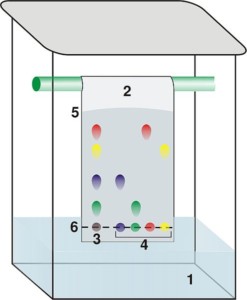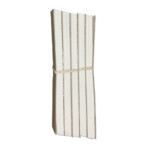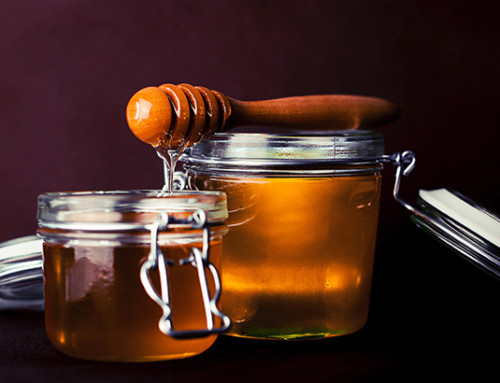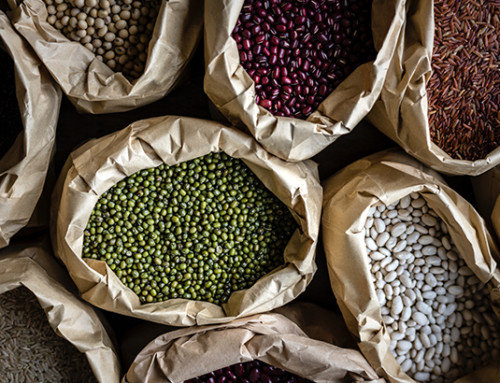Some of you may not know that we actually sell chromatography paper in addition to our treated test strips. We have actually been selling it for many years, but it’s not one of our most popular or well-known items.
Chromatography is a method of separating out a mixture of chemicals, in gas or liquid form, by passing them through a medium where they’ll move at different rates. There are different methods of doing this, but using chromatography paper is a fast, easy and inexpensive method. It is a qualitative, not quantitative, method of identifying the chemical components in a mixture. Other methods include gas and column chromatography.
 So how does it work exactly? Porous paper, such as filter paper, is the best type of paper used for chromatography. The paper is absorbent, so essentially, the components absorb at different rates, creeping up the paper. A small sample of the mixture is placed on the paper, which is in contact with a solvent. The solvent moves through the paper, dissolving the spot where the mixture was placed. The components of the mixture move along the paper at the same rate as the solvent.
So how does it work exactly? Porous paper, such as filter paper, is the best type of paper used for chromatography. The paper is absorbent, so essentially, the components absorb at different rates, creeping up the paper. A small sample of the mixture is placed on the paper, which is in contact with a solvent. The solvent moves through the paper, dissolving the spot where the mixture was placed. The components of the mixture move along the paper at the same rate as the solvent.
However, chemicals with a stronger attraction to the paper than the solvent will move more slowly, while chemicals with a stronger attraction to the solvent will move more quickly. This is how the chemicals are separated out on the paper.
Paper chromatography is often used to identify and separate colored mixtures like pigments. With that in mind, let’s try an easy chromatography paper experiment that anyone can try at home so you can see for yourself what we’re talking about!
Materials
- Chromatography paper
- Pens (Hint: try different brands and colors)
- Food coloring
- Clear plastic cups
- Water
Procedure
- Using our chromatography paper strips, mark a dot ½” from the bottom of a strip with a pen. Proceed to do the same thing on different strips with the different pens you have chosen to test.
- Tape each strip perpendicular to the pen you marked it with, so that when the pen rests across the cup, the strip will hang down into the cup. This way, you can also keep track of which pen was used on each strip of paper.
- Make predictions in your laboratory notebook about which pens will travel the fastest. Try making a chart and order each item from 1 being the fastest to the last item being the slowest (total number based on however many items you’re testing).
- Pour water into each cup until the bottom of the strip is just touching the water. Leave the chromatography paper strip hanging in the water until the color has traveled most of the way up the strip.
- How accurate were your predictions? Why do you think some traveled faster than others? Some components of the ink traveled farther than others, resulting in a spread of colors for you to see. How many colors are you able to see? If you tested two black pens from two different brands, did they have different colors?
Going Further
 If you want to take this experiment a step further, this is where the food coloring will come into play. Many dyes contain numerous colors, and this is where chromatography really gets fun. Watching the colors separate out of what appeared to be one color initially is really fun!
If you want to take this experiment a step further, this is where the food coloring will come into play. Many dyes contain numerous colors, and this is where chromatography really gets fun. Watching the colors separate out of what appeared to be one color initially is really fun!
Using new chromatography paper strips, again, suspend each strip hanging into a cup. Pour water into each cup until it’s just barely touching the bottom of the strip. Record your predictions in your laboratory notebook. What colors do you think you will find from each different food coloring? Now place a drop of food coloring in each cup, and see what happens. Did it separate into colors? Were your predictions right? You can even try mixing different food colorings together to see what happens.
In this experiment, water was our “solvent”. This is what moved through the paper, carrying the components with it. Alcohol is also often used as a solvent, and in fact, we use it in making of many of our test strip chemical solutions. Try using a different solvent in another chromatography experiment. Grab some rubbing alcohol or nail polish and try it with permanent markers, like brightly colored Sharpies, that don’t dissolve in water.
Chromatography paper is a fun and easy way to separate color pigments. There are plenty of other chromatography paper experiments out there. For example, you can use candy with dyes, like Skittles or M&Ms, use different colored highlighters, and you can even make some colorful crafts with your chromatography paper once your experiment is finished. Let’s see what you can come up with!







Leave A Comment